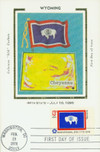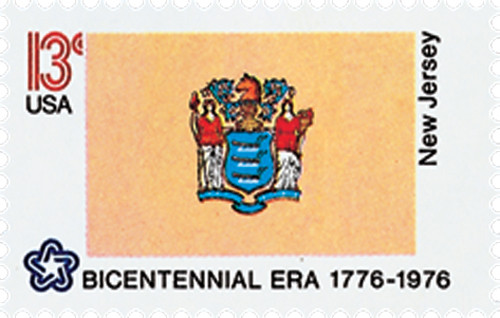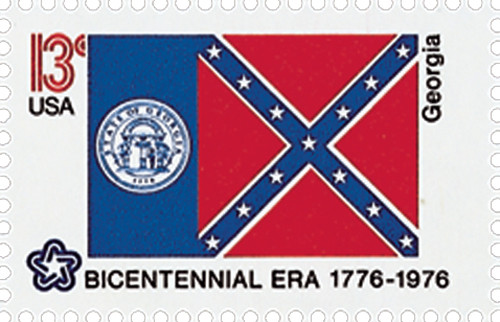
# 1676 - 1976 13c State Flags: Wyoming
U.S. 1676
1976 Wyoming
State Flags
American Bicentennial Series
• First time a sheet 50 had all different stamp designs
• Part of the American Bicentennial Series
Stamp Category: Commemorative
Series: American Bicentennial Series
Value: 13¢ First-class postage rate
First Day of Issue: February 23, 1976
First Day City(s): Washington, DC
Quantity Issued: 8,720,100 (panes of 50)
Printed by: Bureau of Engraving and Printing
Printing Method: Photogravure
Format: Sheet of 50
Perforations: 11
Why the stamp was issued:
The United States Postal Service celebrated the American Bicentennial with a full pane of the Union’s fifty state flags.
About the stamp design:
In 1916, the Wyoming chapter of the Daughters of the American Revolution decided it was time for their state to have an official flag. They held a contest to select a design.
Verna Keays had just graduated from the Art Institute of Chicago, and her father encouraged her to submit an entry in the contest. One morning she awoke with an image in her mind, which she sketched out and immediately sent in. Her winning design earned her a $20 prize.
Keays’ image features a bison, the state mammal of Wyoming and a symbol of the plains. The Great Seal is branded on the shoulder of the buffalo. The blue field of the flag is a reminder of the mountains and sky. The red border represents the Indians who lived on the land. The white exemplifies purity.
The central figure in the state’s seal is a woman standing before a banner proclaiming the state’s motto, “Equal Rights.” Before Wyoming became a state, the territorial government allowed women to vote beginning in 1869. It was the first government in the world to acknowledge this right. Because of this distinction, Wyoming has been nicknamed “The Equality State.”
About the printing process:
Printed by the Bureau of Engraving and Printing on their seven-color Andreotti gravure press (601) which was their work horse for multicolored stamps.
About the American Bicentennial Series:
In the 1970s, America celebrated its 200th anniversary with hundreds of national events commemorating the heroes and historic events that led to our nation’s independence from Great Britain. The U.S. Postal Service issued 113 commemorative stamps over a six-year period in honor of the U.S. bicentennial, beginning with the American Revolution Bicentennial Commission Emblem stamp (U.S. #1432). As a group, the Bicentennial Series chronicles one of our nation’s most important chapters, and remembers the events and patriots who made the U.S. a world model for liberty.
Several of the stamps honored colonial life – craftsmen and communication. Other stamps honored important battles including Lexington and Concord, Bunker Hill, and Saratoga. Significant events such as the Boston Tea Party, the meeting of the First Continental Congress, and the Declaration of Independence were featured as well. The stamps also honored many significant people such as George Washington, Sybil Ludington, Salem Poor, and the Marquis de Lafayette.
Many of the stamps feature classic artwork. For instance, the set of four souvenir sheets picture important events recreated by noted artists such as John Trumbull. The Bicentennial Series also includes an important US postal first – the first 50-stamp se-tenant – featuring all 50 state flags. The format proved to be popular with collectors, and has been repeated many times since.
The American Bicentennial Series is packed with important US history – it tells the story of our nation’s fight for independence through stamps.
History the stamp represents:
On July 10, 1890, Wyoming got added as the 44th state of America.
In the mid-1700s, French trappers probably became the first whites to enter Wyoming. However, the area remained unexplored until after the 1800s. Most of Wyoming was purchased by the United States in the Louisiana Purchase of 1803. American trappers then came to the area. In 1807, John Colter became the first European to travel across the Yellowstone area. A party of fur traders led by Robert Stuart found an easy way to cross the mountains, which became known as the South Pass.
In 1833, while leading a fur-trading and -trapping party, Captain Benjamin L. E. de Bonneville discovered an oil spring in the Wind River Basin. Traders William Sublette and Robert Campbell established Fort William in eastern Wyoming. This fort was later renamed Fort Laramie, and was the area’s first permanent settlement.
Lieutenant John C. Frémont explored the Wind River Mountains in 1842 and ’43. The famous scout Kit Carson served as Frémont’s guide. Based on Frémont’s report, Congress decided to build a series of forts along the Oregon Trail to protect settlers moving west. In 1849, the government bought Fort William, which was later renamed Fort Laramie.
Sections of present-day Wyoming had been part of the territories of Louisiana, Missouri, Nebraska, Oregon, Washington, Idaho, Utah, and Dakota. Part of southern Wyoming belonged to Spain from the 1500s to the 1800s. Spain lost control of this territory to Texas in 1836. All of Wyoming became U.S. territory when Texas joined the Union in 1845.
During the 1840s, many settlers traveled across Wyoming, heading to the West. Travelers utilized three famous trails: the California Trail; the Mormon Trail, which went to Utah; and the Oregon Trail, to the Pacific Northwest. All three trails used the South Pass through the mountains, but separated after crossing. Settlers traveling through southern Wyoming used the Overland, or Cherokee, Trail. This trail joined others at Fort Bridger. Thousands of people passed through Wyoming, but few stayed.
At first, the Plains Indians were tolerant of the wagon trains crossing their land. In fact, Indians often assisted the travelers. But by 1849, the number of settlers began to alarm the Indians. Whites killed or frightened away the wild animals, created massive grass fires on the Prairies, and introduced diseases. Some fighting broke out between Indians and settlers, and the U.S. Army often intervened. During the 1860s, settlers were using the Bozeman Trail to reach Montana, where gold had been discovered. This increased the Indian attacks. Fort Phil Kearny was built in 1866, to keep the Bozeman Trail open. Sioux warriors led by Chief Red Cloud laid siege to the fort, forming what came to be known as the Circle of Death. Hundreds of soldiers died before a treaty was signed. The U.S. gave up Fort Phil Kearny and two other forts. Then, the Indians agreed to allow the construction of the Union Pacific Railroad in southern Wyoming.
Wyoming’s mineral resources, especially gold, attracted many settlers even before the Indian fighting had ended. The growth of towns was fueled by the Union Pacific Railroad, which entered the area in 1867. In 1868, the Territory of Wyoming was created.
On July 10, 1890, Wyoming achieved statehood. This attracted many settlers to the state. Most of these people started small cattle ranches.
Click here to read the act that granted women’s suffrage in Wyoming.
U.S. 1676
1976 Wyoming
State Flags
American Bicentennial Series
• First time a sheet 50 had all different stamp designs
• Part of the American Bicentennial Series
Stamp Category: Commemorative
Series: American Bicentennial Series
Value: 13¢ First-class postage rate
First Day of Issue: February 23, 1976
First Day City(s): Washington, DC
Quantity Issued: 8,720,100 (panes of 50)
Printed by: Bureau of Engraving and Printing
Printing Method: Photogravure
Format: Sheet of 50
Perforations: 11
Why the stamp was issued:
The United States Postal Service celebrated the American Bicentennial with a full pane of the Union’s fifty state flags.
About the stamp design:
In 1916, the Wyoming chapter of the Daughters of the American Revolution decided it was time for their state to have an official flag. They held a contest to select a design.
Verna Keays had just graduated from the Art Institute of Chicago, and her father encouraged her to submit an entry in the contest. One morning she awoke with an image in her mind, which she sketched out and immediately sent in. Her winning design earned her a $20 prize.
Keays’ image features a bison, the state mammal of Wyoming and a symbol of the plains. The Great Seal is branded on the shoulder of the buffalo. The blue field of the flag is a reminder of the mountains and sky. The red border represents the Indians who lived on the land. The white exemplifies purity.
The central figure in the state’s seal is a woman standing before a banner proclaiming the state’s motto, “Equal Rights.” Before Wyoming became a state, the territorial government allowed women to vote beginning in 1869. It was the first government in the world to acknowledge this right. Because of this distinction, Wyoming has been nicknamed “The Equality State.”
About the printing process:
Printed by the Bureau of Engraving and Printing on their seven-color Andreotti gravure press (601) which was their work horse for multicolored stamps.
About the American Bicentennial Series:
In the 1970s, America celebrated its 200th anniversary with hundreds of national events commemorating the heroes and historic events that led to our nation’s independence from Great Britain. The U.S. Postal Service issued 113 commemorative stamps over a six-year period in honor of the U.S. bicentennial, beginning with the American Revolution Bicentennial Commission Emblem stamp (U.S. #1432). As a group, the Bicentennial Series chronicles one of our nation’s most important chapters, and remembers the events and patriots who made the U.S. a world model for liberty.
Several of the stamps honored colonial life – craftsmen and communication. Other stamps honored important battles including Lexington and Concord, Bunker Hill, and Saratoga. Significant events such as the Boston Tea Party, the meeting of the First Continental Congress, and the Declaration of Independence were featured as well. The stamps also honored many significant people such as George Washington, Sybil Ludington, Salem Poor, and the Marquis de Lafayette.
Many of the stamps feature classic artwork. For instance, the set of four souvenir sheets picture important events recreated by noted artists such as John Trumbull. The Bicentennial Series also includes an important US postal first – the first 50-stamp se-tenant – featuring all 50 state flags. The format proved to be popular with collectors, and has been repeated many times since.
The American Bicentennial Series is packed with important US history – it tells the story of our nation’s fight for independence through stamps.
History the stamp represents:
On July 10, 1890, Wyoming got added as the 44th state of America.
In the mid-1700s, French trappers probably became the first whites to enter Wyoming. However, the area remained unexplored until after the 1800s. Most of Wyoming was purchased by the United States in the Louisiana Purchase of 1803. American trappers then came to the area. In 1807, John Colter became the first European to travel across the Yellowstone area. A party of fur traders led by Robert Stuart found an easy way to cross the mountains, which became known as the South Pass.
In 1833, while leading a fur-trading and -trapping party, Captain Benjamin L. E. de Bonneville discovered an oil spring in the Wind River Basin. Traders William Sublette and Robert Campbell established Fort William in eastern Wyoming. This fort was later renamed Fort Laramie, and was the area’s first permanent settlement.
Lieutenant John C. Frémont explored the Wind River Mountains in 1842 and ’43. The famous scout Kit Carson served as Frémont’s guide. Based on Frémont’s report, Congress decided to build a series of forts along the Oregon Trail to protect settlers moving west. In 1849, the government bought Fort William, which was later renamed Fort Laramie.
Sections of present-day Wyoming had been part of the territories of Louisiana, Missouri, Nebraska, Oregon, Washington, Idaho, Utah, and Dakota. Part of southern Wyoming belonged to Spain from the 1500s to the 1800s. Spain lost control of this territory to Texas in 1836. All of Wyoming became U.S. territory when Texas joined the Union in 1845.
During the 1840s, many settlers traveled across Wyoming, heading to the West. Travelers utilized three famous trails: the California Trail; the Mormon Trail, which went to Utah; and the Oregon Trail, to the Pacific Northwest. All three trails used the South Pass through the mountains, but separated after crossing. Settlers traveling through southern Wyoming used the Overland, or Cherokee, Trail. This trail joined others at Fort Bridger. Thousands of people passed through Wyoming, but few stayed.
At first, the Plains Indians were tolerant of the wagon trains crossing their land. In fact, Indians often assisted the travelers. But by 1849, the number of settlers began to alarm the Indians. Whites killed or frightened away the wild animals, created massive grass fires on the Prairies, and introduced diseases. Some fighting broke out between Indians and settlers, and the U.S. Army often intervened. During the 1860s, settlers were using the Bozeman Trail to reach Montana, where gold had been discovered. This increased the Indian attacks. Fort Phil Kearny was built in 1866, to keep the Bozeman Trail open. Sioux warriors led by Chief Red Cloud laid siege to the fort, forming what came to be known as the Circle of Death. Hundreds of soldiers died before a treaty was signed. The U.S. gave up Fort Phil Kearny and two other forts. Then, the Indians agreed to allow the construction of the Union Pacific Railroad in southern Wyoming.
Wyoming’s mineral resources, especially gold, attracted many settlers even before the Indian fighting had ended. The growth of towns was fueled by the Union Pacific Railroad, which entered the area in 1867. In 1868, the Territory of Wyoming was created.
On July 10, 1890, Wyoming achieved statehood. This attracted many settlers to the state. Most of these people started small cattle ranches.
Click here to read the act that granted women’s suffrage in Wyoming.


















